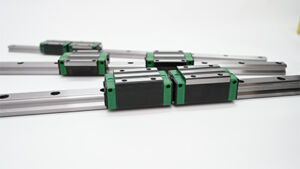For many industries, linear guides with ball and roller bearings are a must-have.
Since they are available in a variety of sizes and capacity levels, they can be used in many different applications. At NSAR, we offer linear guides with hardened raceways, high load capacity, and self-aligning features. Our linear guide systems are also able to work in dirty environments. So, whatever your linear motion guide needs, you’ve come to the right place.
Lightweight, backlash-free movement
Since linear guides are rolling guides, there is no backlash and the movement is lighter than with sliding guides.
Unlimited linear motion is possible
Rolling guides, such as crossed roller guides and ball guides, have limited travel, but the balls of linear guides can circulate infinitely, which means the travel can be extended to the length of the guide.
High allowable load
Linear guides have curved raceways and surface contact between the ball and raceway, and the allowable load is about 13 times higher than that of point contact guide components such as linear bushings. Therefore, linear guides can achieve the same allowable load as point contact type guides with a more compact design.
Linear guides are essential components in various machines and automation systems, ensuring smooth and precise movement along a specific path. Depending on the application, different types of linear guides can be selected. Here are some of the most common types:
Ball Linear Guides
Ball type guides are the most widely used type. They consist of a set of rolling balls between the rail and the carriage, which provide smooth movement and high precision. This type is ideal for applications that require minimal friction and high load capacity. They are widely used in industries such as robotics, CNC machine tools, and packaging.

![]()
Roller Linear Guides
Roller type guides use cylindrical rollers instead of balls, which increase load capacity and reduce wear. These guides are ideal for heavy-duty applications that require high load capacity, such as large machinery or industrial equipment.
Crossed Roller Guides
Crossed Roller Guides have rollers arranged at 90 degrees to each other, supporting both radial and axial loads. They are ideal for applications that require compact design and high rigidity, such as optical and medical devices.
Flat Linear Guides
Flat guides are simpler in design, with a flat surface on which the guide carriage slides. Flat guides are often used in applications where space is limited, and are often used in less demanding, cost-sensitive applications.
Profiled Linear Guides
Profiled linear guides feature a rugged, precision-machined profile that offers high accuracy and load-carrying capacity. They are ideal for high-speed, high-precision applications such as semiconductor manufacturing or automated assembly lines.
Miniature Linear Guides
Miniature linear guides are designed for small applications where space is limited. They are small but highly accurate and are often used in robotics, medical devices, and electronic assembly.
Choosing the right linear guide requires understanding the specific requirements of the application. Considerations include the type of motion, load capacity, and environmental conditions. Linear guide types vary in design and material composition, which affects their performance and suitability for different tasks. Another key aspect to consider is the accuracy of your linear guides; higher accuracy guides are critical in applications such as semiconductor manufacturing and lab automation. Start by determining the characteristics you need for your environment, then calculate the performance you need from your linear guides, and finally consult the guide specifications to ensure you choose the right guide for your application.
Linear guides are designed to make workflows more efficient, no matter what they are. If you have a manufacturing or packaging process, then you understand the importance of accuracy. From start to finish, every moment counts.
Linear guides enable products or packages to move in linear motion. They do this accurately, quickly, and without friction. Additionally, the accuracy of linear guide systems can improve safety. With all these benefits, it’s no wonder that manufacturing programs and warehouses make extensive use of linear guides.
And this linear motion isn’t limited to horizontal movement. Linear guides can also move items vertically, doubling the work of any production line. But the differences don’t stop there.
As mentioned above, linear guide systems come in all shapes and sizes. They can handle any load, as long as you consider the right equipment. Therefore, there are a variety of options available to you. Essentially, choosing the right guide system is all about considering which system will work best for your operation. The best linear guide system for you will be the one that best suits your needs.
Copyright © NSAR Bearings. All rights reserved. Privacy Policy